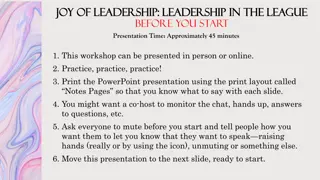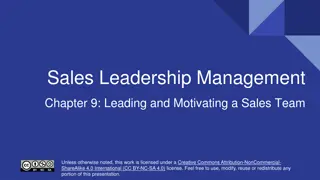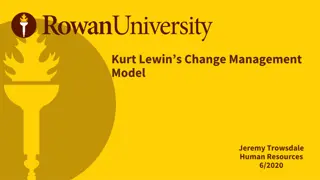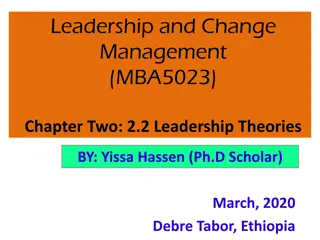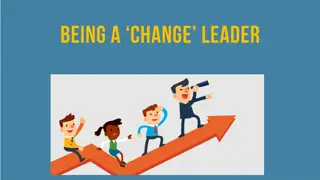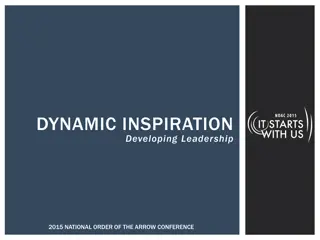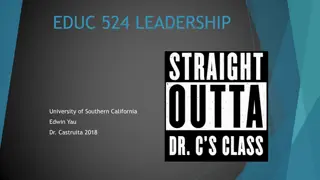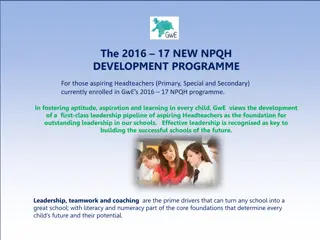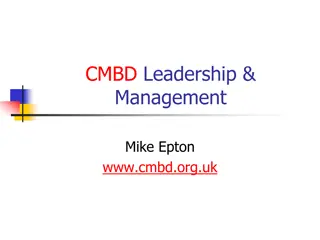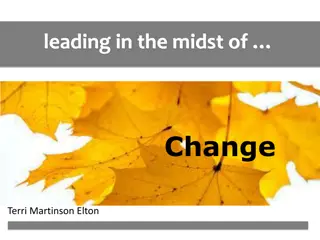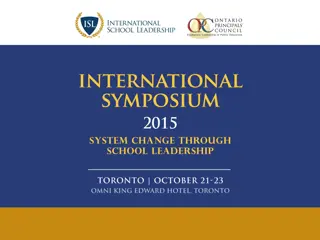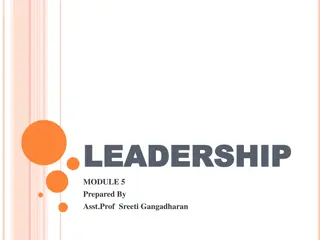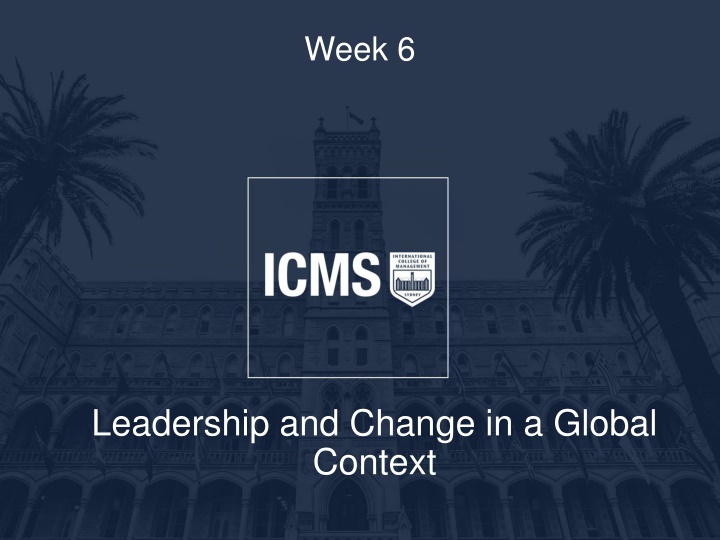
Leadership and Change in a Global Context: Strategies for Successful Organizational Transformation
Discover the key elements of effective leadership and successful change management in today's dynamic global environment. Learn how to navigate resistance, implement innovative strategies, and foster a culture of adaptability to drive organizational growth and success.
Download Presentation

Please find below an Image/Link to download the presentation.
The content on the website is provided AS IS for your information and personal use only. It may not be sold, licensed, or shared on other websites without obtaining consent from the author. If you encounter any issues during the download, it is possible that the publisher has removed the file from their server.
You are allowed to download the files provided on this website for personal or commercial use, subject to the condition that they are used lawfully. All files are the property of their respective owners.
The content on the website is provided AS IS for your information and personal use only. It may not be sold, licensed, or shared on other websites without obtaining consent from the author.
E N D
Presentation Transcript
Week 6 Leadership and Change in a Global Context
Learning Objectives Recognize the environmental forces creating a need for change in today s organizations Describe the qualities of a change leader and how leaders can serve as role models for change Implement the eight-stage model of planned change
Learning Objectives Use appreciative inquiry to engage people in creating change by focusing on the positive and learning from success Apply techniques of enabling immersion, facilitating brainstorming, promoting lateral thinking, allowing pauses, and nurturing creative intuition to expand your own and others creativity and facilitate organizational innovation
Learning Objectives Provide a positive emotional attractor, supportive relationships, repetition of new behaviors, participation and involvement, and after-action reviews to overcome resistance and help people change
Exhibit 15.1 Forces Driving the Need for Change Leadership
Resistance to Change Most people naturally resist change Leaders should be prepared for resistance and find ways to enable people to see the value in changes needed to succeed
Change management require a compelling change story, communicating it to employees and following it up with ongoing communications and involvement
Characteristics of a Leader as a Change Agent Define themselves as change leaders Demonstrate courage Believe in employees being responsible Assimilate and articulate values that promote adaptability Recognize and learn from their own mistakes Capable of managing complexity, uncertainty, and ambiguity Have vision
Exhibit 15.2 The Eight-Stage Model of Planned Organizational Change Sources: Based on John P. Kotter, Leading Change (Boston: Harvard Business School Press, 1996), p. 21.
Appreciative Inquiry (AI) A technique for leading change that engages individuals, teams, or the entire organization by reinforcing positive messages and focusing on learning from success
Exhibit 15.3 Four Stages of Appreciative Inquiry Source: Based on Gabriella Giglio, Silvia Michalcova, and Chris Yates, Instilling a Culture of Winning at American Express, Organization Development Journal 25, no. 4 (Winter 2002), pp. 33 37
Applying Appreciative Inquiry Every Day Developing followers Strengthening teamwork Solving a particular work issue Resolving conflicts
Creativity The generation of ideas that are both novel and useful for improving the efficiency and effectiveness of the organization
Instilling Creative Values To instill creative values: Foster a creative culture Promote collaboration
Foster a Creative Culture Idea incubator Safe harbor where ideas from employees throughout the organization can be developed without interference from company bureaucracy or politics Corporate entrepreneurship Internal entrepreneurial spirit that includes values of exploration, experimentation, and risk taking Idea champions People who passionately believe in a new idea and actively work to overcome obstacles and resistance
Promote Collaboration Create cross-functional teams and self-managed teams Remodel spaces so people from different areas work side by side Use internal Web sites that encourage cross-organizational collaboration Speedstorming
Speedstorming and Brainstorming Speedstorming Using a round-robin format to get people from different areas talking together, generating creative ideas, and identifying areas for potential collaboration Brainstorming A technique that uses a face-to-face group to spontaneously suggest a broad range of ideas to solve a problem Electronic brainstorming Bringing people together in an interactive group over a computer network; sometimes called brainwriting
Keys to Effective Brainstorming No criticism Freewheeling is welcome Quantity desired
Exhibit 15.4 Tools for Helping People Be More Creative
Lateral Thinking A set of systematic techniques for breaking away from customary mental concepts and generating new ones
Exhibit 15.5 Lateral Thinking Checklist Source: Based on Alex Osborn, Applied Imagination(New York: Charles Scribner s Sons, 1963).
Immersion To go deeply into a single area or topic to spark personal creativity
Allow Pauses Activates different parts of the brain Creativity occurs during a mental pause Activities like showering, exercising, driving, walking, and meditating let the intuitive right brain find solutions Leaders should allow people to have quiet spaces when needed
Nurture Creative Intuition Creativity involves two stages Data gathering Flash of insight Creative intuition has a broader reach than any analytical process focused solely on the problem at hand
Personal Compact The reciprocal obligations and commitments that define the relationship between employees and the organization
Exhibit 15.6 Endings Precede Beginnings for Successful Change Source: Based on ideas in William Bridges, Managing Transitions: Making the Most of Change (Cambridge, MA: Da Capo Lifelong Books, 2009).
Keys That Help People Change Provide a positive emotional attractor Make sure people have a support system Use repetition Involve people early Apply after-action reviews
Thank You Thank You

